Warfarin is the most commonly prescribed anticoagulant agent. However, doctors often select analogs for patients with the same therapeutic effect, but not requiring regular monitoring of the INR or international normalized ratio in the form of a quantity prothrombin.
The tool is distinguished by increased efficiency, it helps to improve the condition of patients with pathologies of the heart, blood and some other disorders. The drug is prescribed only after a study involving laboratory monitoring of blood counts.
Record content:
- 1 Form of release, composition and properties of the drug
- 2 Indications for use
- 3 Contraindications
- 4 Instructions for use, dosage
- 5 Precautionary measures
- 6 Side effects and overdose
-
7 Domestic and imported funds that do not require INR control
- 7.1 Dabigatran
- 7.2 Rivaroxaban
- 7.3 Edoxaban
- 7.4 Pradaxa
- 7.5 Xarelto
- 8 Comparison of the cost of the drug and its analogues
- 9 Video about the drug
Form of release, composition and properties of the drug
The medicine is sold in the form of small, blue, biconvex round tablets. They are placed in plastic bottles of 50 or 100 pieces. Each bottle is accompanied by instructions for the use of the medication, it is in an individual cardboard box.
The tablets do not have a specific aroma, which makes it easier to use. The product is also available in blisters of 10, 25 or 50 pieces. Typically, the plates are placed in cardboard boxes, along with instructions for correct use. As the main active component in the composition of the drug, there is a substance warfarin sodium in an amount of 2.5 mg.
The tablets also contain auxiliary components:
- Magnesium stearate.
- Lactose.
- Corn starch.
- Povidone.
Additional ingredients have no therapeutic properties. Tablets are produced by different pharmaceutical companies, so they may contain different excipients.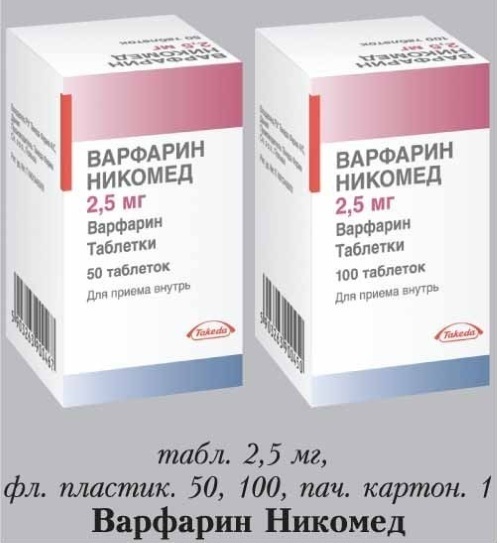
Warfarin (analogs that do not require INR control, may have a different composition) has pronounced anticoagulant properties. The active substance of the composition affects the production process in the liver of special coagulation factors, which leads to a slowdown in blood coagulation and reduces its viscosity.
As a result of this action, there is a relief in the work of the myocardium and an improvement in its contractility. Against the background of these changes, the condition of patients suffering from chronic forms of heart failure and coronary heart disease improves.
The drug has angioprotective properties, which are poorly expressed, but somewhat improve the condition of patients with lesions of peripheral vessels and small capillaries. The medicine reduces pressure on the walls of blood vessels, prevents stretching of their muscle layer, and stimulates cell regeneration.
The pharmacokinetic characteristics of the drug differ in different patients. After taking the tablets inside, their rapid dissolution in the digestive tract and the absorption of the active component into the blood are observed.
Further, other processes take place:
- The absorption of the ingredient is carried out in the small intestine, after which it is distributed throughout the body, providing a therapeutic effect.
- The drug accumulates in blood and tissues. This is due to the long-term onset of therapeutic action. The first result from therapy is observed no earlier than 2-3 days after the start of the course.
- The maximum and constant concentration of the ingredient in the blood is noted only 5-7 days after the start of the use of the tablets.
- The substance binds very well to plasma proteins, therefore its bioavailability is approximately 97-98%, which is considered a high indicator.
- The processing of the ingredients of the composition is carried out in the liver, after which they return to the digestive tract, undergoing repeated processing.
- The agent is partially excreted in the form of inactive metabolites, the rest is evacuated in the form of active decay products of the active substance.
- The withdrawal period takes from 3 to 5 days, depending on the characteristics of the patient's body.
- The main part is excreted with the help of the kidneys, a small amount with feces.
In patients with diseases of the digestive tract, there is a deterioration in the absorption of the active component into the blood. If there is a history of kidney disease, there is a slowdown in the excretion of components from the body.
Indications for use
Warfarin is prescribed to patients with various diseases, like its analogues, which do not require constant monitoring of the INR.
The main indications for the use of the drug:
- Thickening of the blood as a result of the progression of certain diseases.
- The period of rehabilitation after suffering a myocardial infarction. The agent is prescribed to prevent the formation of blood clots and the development of a second attack.
- Tendency to thrombus formation against the background of congenital or acquired disorders.

- Transient ischemic attacks or ischemic stroke in the acute stage. The tool can be used for the primary and recurrent occurrence of symptoms, as well as during the recovery period in order to weaken the load on the vessels.
- Recovery of patients after surgery for the installation of a heart valve.
- Severe heart pathologies, accompanied by damage to the atria, heart rhythm disturbances.
- Acute peripheral vascular thrombosis. The drug is prescribed in the acute stage, during the recovery period or in case of a relapse of the disease.
The tool can be used for the purpose of conducting preventive courses to prevent various complications.
Contraindications
The drug is not prescribed to patients who suffer from intolerance to the components of the composition or have a tendency to similar disorders.
Other contraindications include the following violations:
- A tendency to bleeding against the background of the use of anticoagulants or in the presence of a history of hereditary blood pathologies, for example, hemolytic anemia.
- Internal and external bleeding that is difficult to stop, even with the use of special medications.
- Thrombocytopenia at any stage.
- Acute and severe chronic liver and kidney pathologies. With organ failure, the use of a medicine can provoke complications.
- Coronary aneurysm, accompanied by impaired blood circulation.
- Diagnosis of varicose veins of the digestive tract.
- Ulcerative lesions of the intestine, stomach or duodenum.
- Acute gastritis with increased acidity of gastric juice.
- The use of other anticoagulants for long courses.
- Bacterial endocarditis.
- Hemorrhagic stroke or intracranial hemorrhage associated with head trauma.
- Severe arterial hypertension.
- Pregnancy period. During lactation, the medicine is not contraindicated, but mandatory monitoring of blood counts is required.
- Children and adolescents. There is not enough data on the effect of the drug on the body of children.
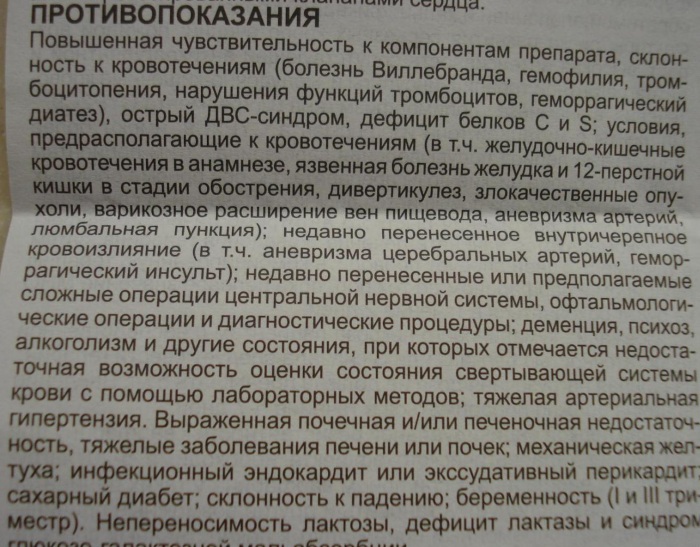 The drug is prescribed with caution to elderly patients, since in most cases they suffer from chronic neurological, gastroenterological or urological pathologies.
The drug is prescribed with caution to elderly patients, since in most cases they suffer from chronic neurological, gastroenterological or urological pathologies.
Instructions for use, dosage
Warfarin (analogs that do not require INR control can be used according to a different scheme) is prescribed after a preliminary examination and detection of a prothrombin indicator. The agent is taken orally at the prescribed dosage.
- The treatment regimen usually involves taking the medication for 2-4 weeks, depending on the patient's condition.
- During the first 5 days, the patient takes 2 tablets per day, it is better to do this at the same time. After that, the blood counts are monitored again.
- If the condition has improved, a maintenance dose is prescribed, which is taken over the next days. The maintenance dose is 2.5 mg of the drug, that is, 1 tablet.
If necessary, the dosage is adjusted, since the blood is examined several times during the course of therapy. Treatment can be extended or shortened, which is individual in each case. There is no standard scheme that would suit absolutely all patients.
Precautionary measures
The drug is not used in combination with other anticoagulants, even in the absence of a therapeutic effect. If the appointment of another drug is required, it is necessary to cancel Warfarin and use another medication after a few days, but only after monitoring the blood counts.
Since the action of the remedy develops over several days, one should not expect a quick result in case of acute disorders. Usually, the drug is used for chronic disorders, when the delay in the onset of the therapeutic result does not matter much.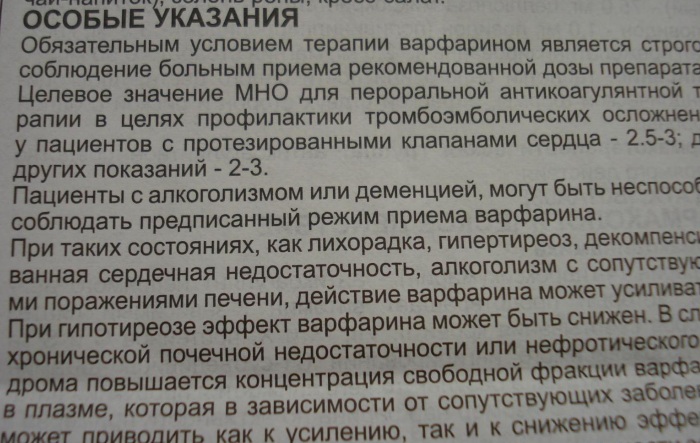
If the medicine is prescribed to elderly patients, the specialist insists on the patient's stay in the hospital, since constant monitoring is required. At home, it is quite difficult to immediately notice negative changes.
Side effects and overdose
Warfarin (analogs that do not require INR control are not considered safer for patients) often provokes complications, even if all recommendations are followed.
| Organs and systems | The most common complications |
| Blood system | On the part of the blood system, a decrease in the level of platelets and coagulation factors is observed, which leads to bleeding, a deterioration in the general condition. With prolonged use of the drug, the symptoms are pronounced, but with short courses, the condition returns to normal after a few days. |
| Heart and blood vessels | With therapy, the drug may develop arrhythmias, tachycardia and pain in the heart. Disorders can be accompanied by a decrease in blood pressure indicators. If the patient suffers from hypertension, then such a complication significantly worsens his condition. |
| Digestive tract | With prolonged use of pills, the appearance of pain in the stomach and an aggravation of the course of chronic diseases are observed. The condition is accompanied by frequent loose stools, flatulence, bloating, nausea, and lack of appetite. |
| Skin | On the part of the skin, an allergic reaction is observed, manifested in the form of a rash, itching, peeling and irritation. In this case, the symptoms may worsen if the patient continues to take the medication. |
| Nervous system | Irritability, fatigue, weakness, and drowsiness are less common. Sometimes the condition is accompanied by apathy or depressive disorders. |

In the absence of treatment, in the event of adverse reactions, the condition is aggravated. With prolonged use of high doses of the drug, an overdose develops. It is accompanied by external and internal bleeding, frequent vomiting during the day.
Overdose can manifest itself in the form of severe headaches, impaired consciousness. Quincke's edema or acute urticaria often develops in patients. The appearance of negative reactions or symptoms of an overdose requires immediate discontinuation of therapy and seeking medical attention.
Domestic and imported funds that do not require INR control
Warfarin (analogs that do not require INR control, often have other therapeutic properties) has several substitutes that have a similar effect, but do not always require strict and frequent monitoring blood counts.
Dabigatran
The drug in tablet form, which contains the active ingredient of the same name in the composition, has pronounced anticoagulant properties. The drug helps prevent the formation of blood clots, makes the blood less viscous, which reduces the load on the heart and blood vessels.
Patients take pills for 1-3 weeks, depending on the severity of the disorders. The daily dosage is 1-2 tablets, but in each case it can be adjusted taking into account the characteristics of the organism of a particular patient.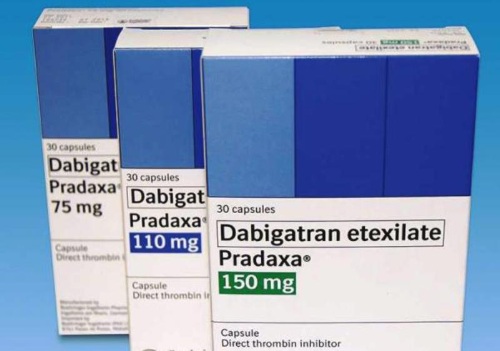
The drug has contraindications:
- Age under 18.
- Pregnancy and lactation period.
- The presence of an artificial valve in the patient's heart.
- Severe pathologies of the kidneys and liver.
- Acute diseases of the digestive tract.
- The use of other anticoagulants or drugs based on ketoconazole.
- Acute external or internal bleeding.
The drug does not require strict control of laboratory blood parameters, but this is not considered a reason for its uncontrolled use without preliminary examination.
Rivaroxaban
An effective anticoagulant medication that contains the active ingredient of the same name in the composition and is available in tablet form. The tool is highly effective and is used for the treatment of patients suffering from thrombosis and various pathologies, accompanied by increased blood clotting.
The daily dosage of the drug for patients is 10 mg, but in some cases it is increased to 20 mg. The application lasts from 2 to 6 weeks, depending on the severity of the symptoms of the underlying disease, the presence of concomitant deviations.
The drug does not require constant monitoring of laboratory blood parameters, but specialists usually prescribe an analysis before prescribing tablets and after undergoing a therapeutic course.
The remedy is contraindicated:
- children;
- adolescents;
- pregnant women;
- lactating women.
It is not prescribed for a tendency to bleeding, acute pathologies of the digestive tract, as well as in the case of a hemorrhagic stroke at any stage. With extreme caution, the medication is prescribed to patients with diseases of the liver and kidneys.
Edoxaban
Anticoagulant in tablet form, which contains the ingredient of the same name in the composition. The remedy is prescribed to patients who suffer from cardiovascular pathologies, accompanied by increased blood clotting.
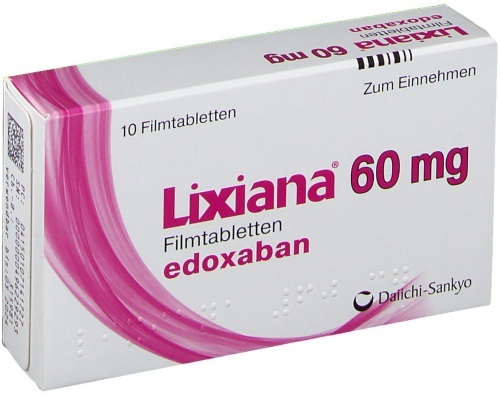
In this case, the medicine helps prevent the aggravation of symptoms against the background of the formation of blood clots. After completing the course of therapy, there is an improvement in the condition, a halt in the progression of pathology.
Tablets are taken orally at 60 mg per day. Usually this dose is sufficient to achieve a therapeutic result. In the absence of an effect, the specialist prolongs the course or increases the dose, but only after monitoring the blood counts.
If the patient does not develop complications, monitoring of indicators is not mandatory, which is considered an advantage over the use of other means. The course of therapy lasts up to 4 weeks.
The drug has fewer contraindications than other anticoagulants. It is not prescribed for lactating and pregnant women, as well as for patients with severe external or internal bleeding. When pathologies of the kidneys or liver are detected, the agent is prescribed with caution.
Pradaxa
An effective and quite popular anticoagulant medication in the form of capsules for oral use, which contains etexilate as the main active ingredient in dabigatran. When used, the drug does not require strict and frequent monitoring of prothrombin time indicators, but this does not make it safer than Warfarin.
Capsules are taken in courses of 2-4 weeks. In each case, the duration of treatment is determined individually. The daily dosage for the patient is 1-2 capsules, depending on the severity of the symptoms. They are taken at the same time throughout the course of therapy.
The drug has contraindications that should be considered before starting use:
- The presence of an artificial valve in the patient's heart.
- Acute or chronic severe kidney or liver dysfunction.
- Bleeding tendency.
- Acute period of hemorrhagic stroke or recovery from such a violation.
- Vascular aneurysm.
- Ulcerative lesions of the stomach, duodenum.
- Malignant neoplasms of the digestive system.
- Intolerance to the components of the composition.
- Pregnancy, lactation.
The drug is not used for the treatment of children and adolescents. If necessary, they are prescribed other medications.
Xarelto
A product based on rivaroxaban, which is available in tablet form. This medication does not require such careful monitoring of the INR, but when using it, the doctor monitors the patient's condition and, if necessary, prescribes laboratory diagnostics.
The drug has pronounced properties, reduces blood viscosity by suppressing the formation of coagulation factors in the liver. Pills are prescribed to patients in order to prevent the formation of blood clots and improve the condition.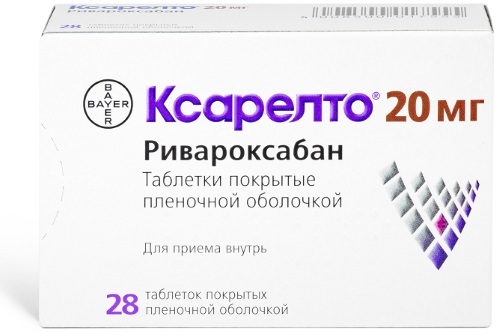
The daily dosage for patients is 10 mg, if necessary, it is increased by 2 times. The tablets are taken in the morning or in the evening, but it is recommended to do this at a specific time. Treatment lasts from 2 to 4 weeks, depending on the degree of neglect of the condition.
The drug is not prescribed for bleeding of varying degrees of neglect, pregnancy and lactation. Do not use the medication for the purpose of treating patients under 18 years of age, as well as when diagnosing intracranial bleeding, coagulopathy. During treatment, blood counts are monitored in case of complications.
Comparison of the cost of the drug and its analogues
The price of Warfarin is quite affordable, since 1 bottle of tablets costs about 120-190 rubles.
However, its counterparts are much more expensive:
- The cost of Dabigatran is approximately 1300-1700 rubles.
- You can buy Rivaroxaban for about 900-1600 rubles.
- The price of Edoxaban starts at 10,000 rubles, which is quite expensive.
- Pradaksa can be purchased for 3500-6000 rubles.
- The cost of Ksarelto is about 1,500 rubles.
The cost of warfarin is quite low, but constant monitoring of INR makes patients look for analogues. They are much more expensive, but therapy does not require strict monitoring of blood counts.
Warfarin is considered a very potent anticoagulant agent that is low cost. Despite this, patients prefer to use drug analogues that do not require regular and strict INR monitoring. They are considered safer, but nevertheless, a doctor's supervision is required, who will notice the deterioration in a timely manner.
Video about the drug
Malysheva about Warfarin:



